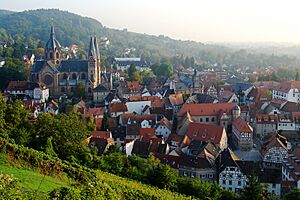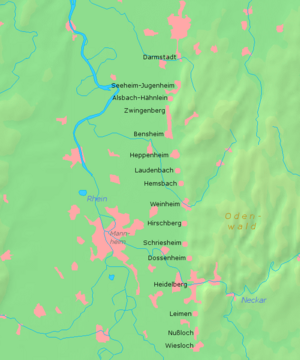Bergstraße (route) facts for kids
The Bergstraße (which means "Mountain Road") is a very old trade route in southwest Germany. It's about 80 kilometers (50 miles) long. This special route and the area around it follow the western edge of the Odenwald forest. It runs from north to south through southern Hesse and northern Baden-Württemberg.
The Bergstraße goes through a special administrative area also called Bergstraße. It also passes through famous wine-growing areas like Hessische Bergstraße and Badische Bergstraße. If you travel between Heidelberg and Weinheim, you might see the OEG tram route running right next to the road!
Contents
Exploring the Bergstraße Route
The Bergstraße follows a nearly straight path from north to south. It's located where the flat Rhine lowlands meet the mountains of the western Odenwald. The road got its name because it runs along the foot of these mountains. Long ago, the Rhine lowlands were too wet to build a road there.
How the Route Follows the B3 Road
Today, the Bergstraße mostly follows the modern B3 road. It starts in the city of Darmstadt. After passing through Darmstadt-Eberstadt, the road splits. One part is called the "Old Bergstraße" and the other is the "New Bergstraße." The new road goes a bit further west. Both routes meet up again in Zwingenberg.
Where the Route Changes in Weinheim
In Weinheim-Lützelsachsen, the old and new Bergstraße roads split again. The new one stays west of the old route until they both meet once more in Heidelberg-Handschuhsheim. Even after crossing the Neckar river from Heidelberg to Wiesloch, the road is still known as the Bergstraße. However, the special climate and landscape of the Bergstraße are not as strong in this southern part.
Regions Along the Bergstraße
The Bergstraße travels through three rural districts and two urban districts. These are Darmstadt, Landkreis Darmstadt-Dieburg, Kreis Bergstraße, Heidelberg, and the Rhein-Neckar-Kreis. The northern part of the route is in Hesse, and the southern part is in Baden. The border between these two German states is between Heppenheim and Laudenbach.
History of the Mountain Road's Name
People have used the Bergstraße as a trade route since Roman times. The name bergstrasen was first written down in 1165. A Latin name, strata montana, came later during the Renaissance, not from the Romans. Older names for the route include strata publica (from 795), platea montium (from 819), and montana platea (from 1002).
The exact path of the road has changed a little over hundreds of years. In 1955, workers found parts of an old paved Roman road in Heppenheim while fixing drains. These ancient stones were moved to the Ferdinand Feuerbach Unit. You can still see them there today, covering an area of about 20 square meters.
Towns and Cities Along the Bergstraße
The Bergstraße passes through many interesting towns and cities. Here they are, listed from north to south:
- Darmstadt
- Darmstadt
- Darmstadt-Eberstadt
- Seeheim-Jugenheim (along the Old Bergstraße)
- Malchen
- Seeheim
- Jugenheim
- Alsbach-Hähnlein (along the Old Bergstraße)
- Alsbach
- Bickenbach (along the New Bergstraße)
- Zwingenberg
- Bensheim
- Bensheim-Auerbach
- Bensheim
- Heppenheim
- Laudenbach (Rhein-Neckar)
- Hemsbach
- Weinheim
- Weinheim-Sulzbach
- Weinheim
- Weinheim-Lützelsachsen
- Weinheim-Hohensachsen
- Hirschberg an der Bergstraße
- Großsachsen
- Leutershausen
- Schriesheim
- Dossenheim
- Heidelberg
- Heidelberg-Handschuhsheim
- Heidelberg-Neuenheim
- Across the Neckar river
- Heidelberg
- Heidelberg-Rohrbach
- Leimen (Baden)
- Nußloch
- Wiesloch
Nature and Scenery of the Bergstraße
The area right along the Bergstraße is also named after the road. The weather here is usually very mild and sunny. It gets about 1500 hours of sunshine every year! Spring arrives earlier here than almost anywhere else in Germany.
Rich Farmlands and Special Plants
Because of the warm climate and good soil (a fertile loess soil), the Bergstraße is one of Germany's best places for growing fruit. You'll find grapes, other fruits, and even almonds, sweet chestnuts, and walnuts. The Bergstraße is especially famous for its almond trees, which bloom as early as March. Other plants that usually grow in warmer, Mediterranean places, like figs and olive trees, also grow here.
Germany's "Little Italy"
Because of the mild climate, Joseph II, Holy Roman Emperor (who ruled from 1765 to 1790) once visited the Bergstraße. He was on a trip back from Frankfurt am Main. He is said to have exclaimed, "This is where Germany starts to become Italy!"
Modern Life and Tourism
The Bergstraße is part of a busy area where the Rhine, Main, and Neckar rivers meet. So, it's quite developed with many industries. But tourism is also very important here.
Besides the beautiful countryside, there are many important sights to see:
- Heidelberg with its famous castle and old city.
- Darmstadt, a center for Jugendstil (Art Nouveau) art, with its artists' colony.
- A chain of castles along the edge of the Odenwald forest, like Castle Frankenstein, Alsbach Castle, Auerbach Castle, Starkenburg above Heppenheim, Wachenburg and Windeck above Weinheim, and Strahlenburg above Schriesheim.
- The charming old town centers in many cities and towns. Heppenheim is almost completely preserved (except for its city walls). It has a splendid city hall, a marketplace, the "Bergstraße Cathedral," and many medieval half-timbered houses.
- Other lovely old towns include Zwingenberg, Bensheim, and Weinheim.
- A truly special sight near the Bergstraße is the Carolingian-era entrance hall of the old Lorsch monastery. UNESCO has named it a world cultural heritage site.
Ancient Settlements Along the Bergstraße
People have lived in the Bergstraße area for a very long time. Digs have found items from ancient cultures like the Linear Pottery culture (around 5500 BC) and the Corded Ware culture (around 2500 to 1500 BC). These early people farmed the land and raised cattle here.
The population grew during Roman times. Settlements of different sizes were built, including villae rusticae. These were like Roman farm estates. They were the main way people lived and worked in the mountainous Bergstraße region between 120 and 260 AD.
See also
 In Spanish: Bergstraße para niños
In Spanish: Bergstraße para niños
- Hessische Bergstraße, one of 13 regions for quality wine in Germany




